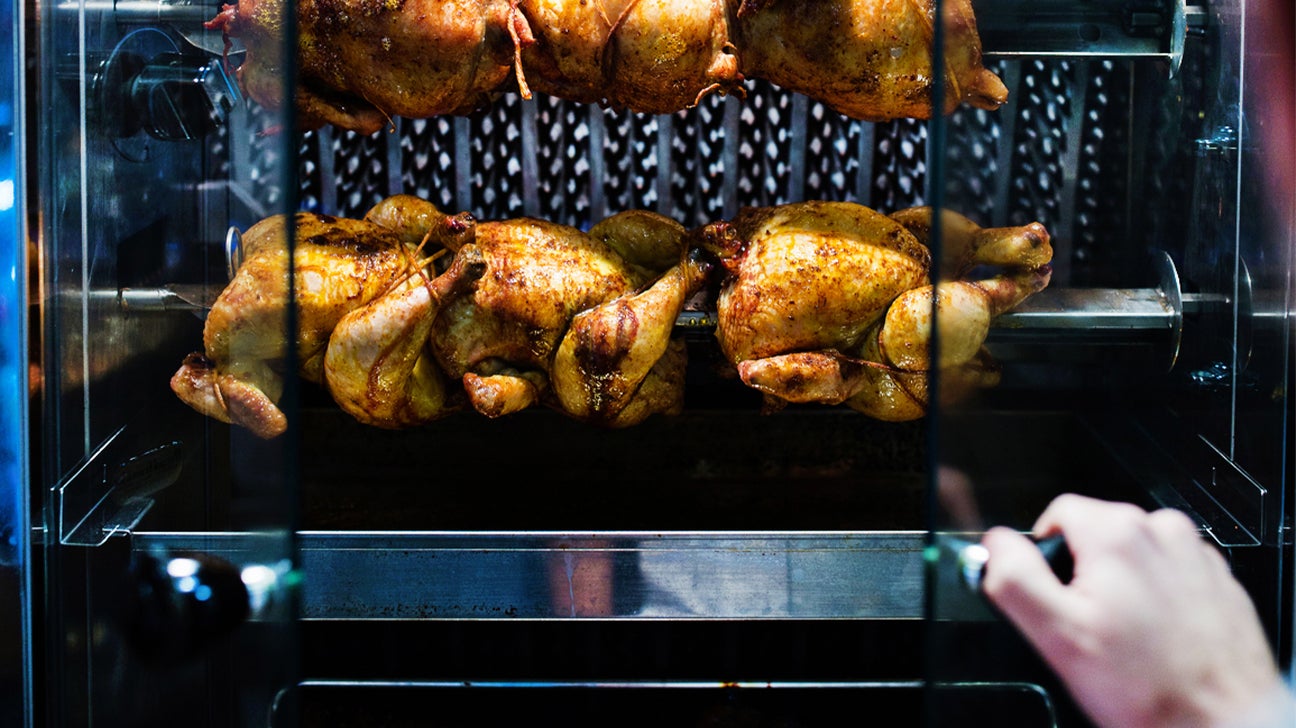Let’s be honest – we’ve all been there. It’s 5:30 PM, you’re exhausted from work, and cooking dinner from scratch sounds about as appealing as a root canal. Then you remember the grocery store’s rotisserie chicken section, with those golden-brown birds spinning hypnotically on the spit. Your stomach growls as you imagine that juicy, perfectly seasoned meat that requires zero prep work from you.
But wait – is that rotisserie chicken actually good for you? Or is convenience coming at a nutritional cost? I’ve done the research so you don’t have to, and the answer might surprise you.
The Nutritional Breakdown: What’s in Your Rotisserie Chicken?
Rotisserie chicken has a lot going for it from a nutritional standpoint. Here’s what makes it a potentially healthy choice:
- High-quality protein: A 3-ounce serving provides around 24 grams of protein, essential for muscle maintenance and growth
- Low in calories: The same serving contains approximately 115 calories
- Low in fat: With only about 2.5 grams of fat per serving
- Rich in vitamins and minerals: Contains B vitamins, selenium, zinc, copper, phosphorus, and iron
The dark meat (thighs and legs) contains even more nutrients than white meat (breast) with higher levels of iron, zinc and B12. Chicken is also a good source of choline, which supports brain health, mood regulation, and memory.
But before you grab that chicken and run to the checkout there are some less appetizing aspects to consider.
The Sodium Situation: A Hidden Health Concern
The biggest health concern with rotisserie chickens is their often sky-high sodium content. Consumer Reports found dramatic differences between brands:
| Store | Sodium per 3-oz Serving |
|---|---|
| Sam’s Club | 550 mg |
| Costco | 460 mg |
| Whole Foods (classic) | 450 mg |
| Boston Market | 170-368 mg |
| Wegmans (organic) | 95 mg |
| Whole Foods (organic) | 70 mg |
| Kroger (Simple Truth) | 40 mg |
For perspective chicken you roast at home without salt has about 60-70 mg of sodium per serving. The American Heart Association recommends consuming no more than 2300 mg of sodium daily, with an ideal limit of 1,500 mg for most adults.
This means a single serving of some rotisserie chickens can provide nearly a quarter of your daily sodium limit!
What About Those Additives?
Most store-bought rotisserie chickens aren’t just seasoned on the outside. As Tom Super from the National Chicken Council told Consumer Reports, “Essentially, all rotisserie chickens are enhanced with a solution [injected into the bird] to keep the birds moist and tasty.”
This solution typically contains:
- Salt (hence the high sodium)
- Various preservatives
- Flavor enhancers
- Phosphates
- Natural flavors (which aren’t always as “natural” as they sound)
- Sugar
- Gums and carrageenan
While these additives are approved by food safety authorities and considered safe, they do make rotisserie chicken a processed food option. If you’re trying to eat mostly whole, unprocessed foods, this is something to consider.
The Skin Situation: To Eat or Not to Eat?
That crispy, golden skin is arguably the most delicious part of a rotisserie chicken, but it’s also where much of the fat and sodium lives. Removing the skin can significantly reduce both:
- With skin: Higher in calories, fat, and sodium
- Without skin: Lower in calories, fat, and sodium
Nutritionist Karolin Saweres recommends removing most of the skin to cut down on saturated fat and calories. But hey, life is about balance – keeping a little bit of that crispy goodness won’t hurt!
How to Make Rotisserie Chicken Part of a Healthy Meal
Just because rotisserie chicken has some nutritional drawbacks doesn’t mean you should avoid it completely. Here’s how to make it part of a healthy, balanced meal:
- Choose wisely: Look for plain or lightly seasoned options when possible
- Remove some or all of the skin: Especially if you’re watching your fat intake
- Balance your plate: Fill half your plate with vegetables, a quarter with your chicken, and a quarter with a whole grain starch like brown rice or quinoa
- Add healthy fats: Incorporate avocado, olive oil, or nuts alongside your chicken
- Use it throughout the week: Stretch one chicken into multiple meals to get more value
As nutritionist Samantha Cassetty points out, “You don’t have to cook everything from scratch to be healthy. A rotisserie chicken can be part of a nutritious, balanced eating pattern, especially if you serve it with vegetables, whole starches and healthy fats.”
Cost and Convenience Considerations
Most rotisserie chickens cost around $10, making them an affordable protein option compared to restaurant meals. They’re especially economical if you can stretch one chicken across multiple meals.
The time-saving aspect is huge too. When you’re exhausted or busy, having a pre-cooked protein can make the difference between eating a home-prepared meal and ordering takeout, which is often higher in calories, fat, and sodium.
Environmental and Sustainability Factors
If environmental impact matters to you, there are a few things to consider with rotisserie chickens:
- Chicken has a lower carbon footprint than beef or pork
- Chickens convert feed to meat more efficiently than other livestock
- However, rotisserie chickens almost always come in single-use plastic containers
- Many grocery stores don’t disclose where their chickens come from or how they were raised
If sustainability is important to you, look for organic rotisserie chickens or those labeled “raised without antibiotics.” The USDA Organic seal ensures the chickens ate organic feed and had access to the outdoors.
Smart Shopping: When to Buy and What to Look For
Want to get the freshest rotisserie chicken? Here are some tips:
- Best shopping times: Most stores cook fresh batches every 2-4 hours between 8/9 AM and 4/6 PM
- Peak hours: The best selection is typically available during evening peak hours (5-7 PM)
- Check cooking time: Look on the label for when each chicken was cooked
- Ask questions: Don’t hesitate to ask the deli department about their cooking schedule
Food Safety and Storage Tips
Once you get your rotisserie chicken home, proper handling is important:
- Refrigerate promptly: Don’t leave it sitting out for more than 2 hours
- Storage time: Cut into pieces and refrigerate in a covered container for up to 4 days
- Freezing: Leftovers can be frozen for up to 4 months
- Pink meat?: Don’t worry if the meat near the bone looks pink – this is normal in younger birds and doesn’t mean it’s undercooked
Creative Ways to Use Leftover Rotisserie Chicken
One rotisserie chicken can provide multiple meals. Here are some healthy ways to use the leftovers:
- Shred it for whole-grain bowls with quinoa and veggies
- Make a nutritious chicken salad with olive oil, herbs, nuts, and dried fruit
- Use it in tacos with whole-grain tortillas, tomatoes, and beans
- Make chicken noodle soup (bonus: use the bones for homemade broth!)
- Create a green chili with white beans and salsa verde
- Toss it into a pasta salad with plenty of vegetables
The Bottom Line: Are Rotisserie Chickens Healthy?
So, are rotisserie chickens healthy? Like many food choices, the answer is: it depends.
Rotisserie chicken can be a nutritious, convenient protein option, particularly when you:
- Choose lower-sodium versions
- Remove some or all of the skin
- Pair it with plenty of vegetables and whole grains
The biggest concerns are the sodium content and additives in many store-bought versions. If you’re watching your sodium intake or trying to avoid processed foods, you might want to roast your own chicken at home when possible.
But in our busy world, sometimes convenience wins out – and that’s okay! A rotisserie chicken is still likely to be a healthier choice than many restaurant meals or processed frozen dinners.
As with most things in nutrition, it’s about balance and making the best choices you can within your lifestyle constraints. Sometimes that perfectly roasted, no-effort chicken is exactly what you need to get a healthy dinner on the table after a long day. And that’s a win in my book!
What’s your favorite way to use rotisserie chicken? Do you have a go-to brand that’s lower in sodium? I’d love to hear your thoughts in the comments!

Is Rotisserie Chicken Sustainable?
When considering sustainability in modern farming, chicken emerges as a more environmentally friendly option compared to other animal proteins (5).
Producing chickens requires less land, water, and energy, which significantly reduces environmental impact. The carbon footprint of chicken is lower than that of beef or pork due to more efficient feed conversion rates—meaning chickens convert feed into meat more effectively than cattle or pigs. This efficiency minimizes the resources needed for chicken farming.
However, feed and water aren’t the only considerations for sustainability. Rotisserie chickens are almost always packaged in single-use plastic. Whether it’s a plastic bag with a zip-close top or a shell-top container, this plastic is rarely recycled and is most likely to end up in a landfill. There’s not much you can do about that; plastic packaging is a popular choice because it’s often cheaper, more light-weight, and sturdier than alternatives. But be mindful when buying rotisserie chickens because while you can’t avoid plastic, you can avoid food waste.
Here are some delicious meal ideas and food safety tips to show you how!
Rotisserie Chicken Nutrition Facts
When it comes to rotisserie chicken nutrition, a lot depends on who made it, how it’s seasoned, and what else you add.
Generally speaking, rotisserie chicken has fewer calories compared to fried chicken that is breaded before cooking. It’s also lower in fat. But it is higher in sodium than roasted chicken or baked chicken you might make at home.
Typically, a three-ounce serving of rotisserie chicken contains around 115 calories, with 24 grams of protein and only 2.5 grams of fat. This makes it an excellent source of lean protein, which is crucial for muscle repair and growth. Both white and dark meat provide B vitamins and important minerals like selenium, zinc, copper, phosphorus, and iron. Dark meat cuts like chicken thighs are even more nutritious than white meat cuts like chicken breast because of the higher levels of B12, zinc, and iron. Choline is another key nutrient found in chicken (and eggs!) which helps regulate mood, memory, and healthy brain development and function.

Is Rotisserie Chicken Healthy? – Ask a Nutritionist
FAQ
What are the disadvantages of rotisserie chicken?
Rotisserie chicken can be high in Advanced Glycation End products (AGEs), which are linked to various health concerns. The high heat used in rotisserie cooking can trigger the Maillard reaction, a chemical process that produces AGEs and high levels can contribute to oxidative stress and inflammation.
Which is healthier, rotisserie or grilled chicken?
Verdict: Which is the Healthiest Option? While two pieces of meat may look the same before cooking, the nutritional value changes depending on the selected method. Rotisserie will drain most of the oil and grease from your meat while grilling will not.
What is the hidden ingredient in Costco rotisserie chicken?
Without it, Costco’s legendary rotisserie chickens wouldn’t be the same. The list of ingredients in the solution is fairly short – water, sodium phosphate, modified food starch, potato dextrin, carrageenan, sugar, dextrose, spice extractives, and salt.
Are grocery store rotisserie chickens processed?
Due to all the additives, rotisserie chicken are considered processed food. But I don’t have time to cook. Or I don’t know how or it’s just me…excuses, excuses. Roasting a whole chicken, which is akin to a rotisserie bird, is as simple as sprinkling herbs and spices on a fresh bird and baking it in an oven for an hour.
